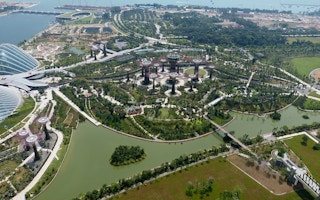When driverless cars become a reality on roads, they might be able to communicate with one another and organise themselves to avoid traffic congestions and other modern-day travel inconveniences. The vehicles’ ability to identify and take the most efficient routes could also have another profound effect: a reduction in cities’ carbon emissions.
The global trend towards “smart” cities that deploy technology in service of citizens will also transform them into environmentally-friendly ones, said panellists at the closing plenary of the International Green Building Conference (IGBC) on Thursday.
“In the past, we had to congregate and meet in person to exchange knowledge,” said Karuna Gopal, president of the Foundation for Futuristic Cities in India. “Now, we have teleconferencing and e-learning, which can reduce greenhouse gas emissions associated with traveling.”
Gopal highlighted other innovations and movements that ease people’s lives and also reduce their impact on the environment, such as wearable medical devices that can accurately diagnose ailments, eliminating unnecessary trips to a doctor or hospital.
Vertical as well as underground farms that boost countries’ food security will also help them to cut back on imports and the carbon footprint of transporting food. “Smart cities are about liveability and the highest quality of life, and that has a lot to do with sustainability too,” said Gopal.
Efficiency and the environment
As countries strive to make their cities smarter and more efficient, this will also reduce waste, noted Edwin Khew, chairman of the Sustainable Energy Association of Singapore. He is also chairman of the Singapore Standards Council, which is examining how smart systems such as sensors and other Internet-connected devices interoperate and communicate with one another.
“In the old days, you had the Sony Betamax and other video systems that were different from each other, and sometimes you had to buy more than one system because the tapes were recorded under different systems,” said Khew. “Today, if you want to be a smart nation or city, everything has to work coherently and efficiently. That’s the same as being green,” he added.
Smart cities also aim to conserve resources, improve their self-reliance and develop holistically – goals they have in common with green cities, noted Khew.
He explained: “They both want systems that use very little energy, for example LED lighting, people’s waste to be taken care of and converted to energy, and everything to be as highly efficient as possible.”
People power
Still, technological innovation is not enough by itself, and could even prove to be a double-edged sword, warned the panellists. Lee Chuan Seng, emeritus chairman of project management and engineering consultancy firm Beca Asia Singapore, shared an anecdote about the potential pitfalls of advancements in energy efficiency.
“Years ago, we were very proud that we could design condominiums with air-conditioners that were a lot more energy-efficient. We did our calculations and estimated that you could save this or that amount each month,” he said. “The response that came back from some purchasers was, ‘That’s wonderful, now we can leave the air-conditioner on all day!’.”
A change in people’s mind-sets is crucial to maximise the potential of smart and green cities, emphasised Ken Yeang, executive director of the Malaysian-based eco-architecture firm T. R. Hamzah and Yeang.
“If people don’t change, then all of the technology will be to no avail. The change has to start with us. We have to move away from the materialistic behaviour of wanting more and more, of wanting things that we don’t need,” he said.
In fact, next year’s IGBC has the working theme of “Build Green, Be the Change”, revealed Ang Kian Seng, group director of the environmental sustainability group and second vice president of the Building and Construction Authority of Singapore and the Singapore Green Building Council.
He said that the theme was inspired by the role that people can play in green cities. “It’s based on the fact that we can be change agents and influence people outside of our network,” he added. “This conference has given us a lot of optimism, and we want to involve even more people.”
Eco-Business is producing a special e-newsletter featuring stories on the proceedings at IGBC 2016, kindly supported by City Developments Ltd and the Building and Construction Authority. Sign up to receive the newsletter here.













